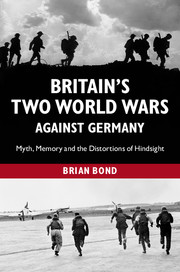Book contents
- Frontmatter
- Contents
- Acknowledgements
- Introduction
- 1 The creation of myths after 1945
- 2 British policy and strategy
- 3 British generalship in the two world wars
- 4 At the sharp end: combat experience in the two world wars
- 5 Attrition in the First World War: the naval blockade
- 6 Attrition in the Second World War: The strategic bombing of Germany
- 7 The transformation of war on the Western Front, 1914–1918
- 8 The British Army’s learning process in the Second World War
- 9 After the wars: Britain’s gains and losses
- Appendix
- Select bibliography
- Index
- References
8 - The British Army’s learning process in the Second World War
Published online by Cambridge University Press: 05 October 2014
- Frontmatter
- Contents
- Acknowledgements
- Introduction
- 1 The creation of myths after 1945
- 2 British policy and strategy
- 3 British generalship in the two world wars
- 4 At the sharp end: combat experience in the two world wars
- 5 Attrition in the First World War: the naval blockade
- 6 Attrition in the Second World War: The strategic bombing of Germany
- 7 The transformation of war on the Western Front, 1914–1918
- 8 The British Army’s learning process in the Second World War
- 9 After the wars: Britain’s gains and losses
- Appendix
- Select bibliography
- Index
- References
Summary
In some respects the British’s Army’s trajectory, in the sense of developing operational skills, was similar in the two world wars. It entered both major European conflicts at their outset and, in comparison with both allies and enemies, was small and under-equipped. It suffered a series of reverses, retreats and outright defeats, worse in the later war, but also learnt from these experiences to become more effective and more professional in the second half of both wars. But there was also a huge contrast, which makes comparison of the learning processes difficult. In the second war the Army confronted the main enemy (Germany) in the principal theatre, North-West Europe, only briefly in 1940 and at greater length in 1944–1945 when it became the junior partner to the United States. Moreover though still stubborn and skilful in defence, the Wehrmacht was suffering devastating losses in the vastly larger struggle on the Eastern Front. Consequently, in sharp contrast to 1914–1918, the British Army never became the principal Service between 1939 and 1945 and played a far less dominant role in the outcome. Moreover, although the Army fought in numerous and varied theatres in both wars, there was no doubt, particularly after 1915, that it was on the Western Front that the war would be decided and that Britain must make her main effort there, no matter how high the cost. For the strategic reasons mentioned above this did not turn out to be the case after May 1940, so the Army had to adjust to remarkably differing conditions in the Middle East (especially North Africa), Italy and North-West Europe. This latter consideration, and the comparatively small scale of Britain’s land forces, made it harder to evolve in the spectacular ways witnessed in 1916–1918, but this also helps to explain why there has been far less criticism of the slow pace of adaptation and development in professional skills, particularly all-arms co-operation in battle, between 1939 and 1945.
- Type
- Chapter
- Information
- Britain's Two World Wars against GermanyMyth, Memory and the Distortions of Hindsight, pp. 144 - 163Publisher: Cambridge University PressPrint publication year: 2014



